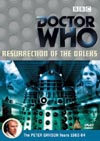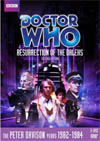Original DVD Extras include:
Post production was once again a huge sore point for various reasons. After finalizing a four-part version for posterity and worldwide sales, the BBC then paired the episodes together so that British audiences would first see the story as two 45-minute episodes. Eric Saward is on the original DVD extras quite rightly nixing British fans' interpretation that such a holy event should cast the story's "proper" format in stone. No, it was designed and shot as a four-parter, and works better that way, with episode one's cliffhanger being too unique for a combined version to do the moment justice.
First ImpressionsWe Canadians were luckier in getting the proper four-part version during its first-run broadcast here in the mid-1980's. I had only seen Daleks in the Peter Cushing films prior to this, and it was super exciting to finally see them reappear on the TV show itself. Dave Chapman did very cool work upgrading the Daleks' extermination beam from what had been seen previously in "Genesis of the Daleks" (story no. 78) and "Destiny of the Daleks" (story no. 104), and though the exterminators' gas weapons in the Cushing movies were cool and somehow very appropriate, good lasers like this were more what I looked forward to.
Getting Post-Production Finishes Out of the Way....Apparently some versions of this story went out without some of the music / sound effects / (visual effects?) that were in the final BBC versions. But even on the "correct" versions, laser effects on the story still seemed half-finished. All the futuristic humanoid characters were left pointing flashlights at each other, and looking hammy while getting hit by absolutely nothing. Obviously, they were meant to have lasers too, and either time or budget or ability had dried up yet again. As before, excessive movement by actors on some shots, in addition to some blocking that would have placed moving actors in front of added beams, contributed to creating far more work for Dave Chapman had he tackled this than was feasible for this show's schedule.But, this story remains too important to be left in such an unfinished state. With so many of the current DVD releases sporting optional new CGI effects, I'm often baffled at the choice of which stories the "Restoration Team" decides to add these to. While they have made some impressive improvements on adventures that didn't really need it, many of those that need it most, like "Resurrection of the Daleks", get ignored. It baffles me how they think that the plain flashlights are okay. Even without the massive script re-structuring to involve the Doctor in more plot-lines, I thought the post-production editing itself, particularly in part one, was unnecessarily messy and cutting back and forth between unrelated settings too often. Early TARDIS interior scenes felt far too short, shaken up, confusing, and unrelated to any neighbouring scenes to make an acceptable introduction to the three regulars, but all this seemed easily fixable by tacking the final cliffhanger scene from "Frontios" (the previous story), onto the beginning of this tale as a pre-title "hook". It properly introduced the regulars and the challenge facing them through their first few scenes in the TARDIS, it didn't give away anything of the previous story's plot, and it went a long way to helping the upcoming adventure seem "big." "We're being pulled towards the middle of the universe..."Disappointingly, the so-called middle of the universe turns out to be London apparently. How quaint. But somehow not surprising. At least the outer-space setting for the other half of the adventure (vaguely specified only as being "remote") managed to make up for this. It could be Earth orbit for all we know, but all things considered, it's more likely and makes better sense to be some far flung nowhere.One of the most confusing things about part one is its failure to adequately establish its over-packed cast of characters, and the fact that in the outer space sections, they are actually supposed to be in two very different locations. Indeed, by the time part one's credits rolled, I found myself looking at lists of unfamiliar character names, played by unfamiliar actors' names. Who was who? Something was obviously missing from dialogue. Not only was the Doctor and/or his companions not meeting most of these people and becoming involved with them as should be happening, but dialogue also clumsily neglected to have the characters refer to each other by name, or on the few occasions when it did, left it unclear or unemphasized. Most characters in this tale are lucky to have their character names used once across all four episodes combined, and you have to dig to find them. Many other character names never get mentioned on screen at all. This did seem to be the wrong way to write a story. The cruiser gets an awesome establishing shot to begin with, but sadly the ship doesn't really show up on screen very effectively after that. By the time the very quick, static establishing shot of the space station flips on and off of the screen, one may very easily assume it is the same place. Additionally, after Lytton has demonstrated such a strong visual commanding presence, all the dialogue of the space station crew discussing the character of their unseen captain I thought on first viewing was describing and referring to Lytton. The commentary even points out the similarity of the hats worn by the station crew and Lytton's gang when not in battle. An obvious remedy seems to be to combine a lot of separate scenes from a location together, especially during part one, to let one beat continue through from start to finish without interrupting it with another. Although extra establishing shots and space/vortex exteriors would be useful everywhere, I have found that one of the most important juxtapositions that can be made is to go from Lytton's second scene on the cruiser, commanding "All troopers to battle stations. Battle speed!", to an exterior of the ship to remind viewers what it looked like (now doing the equivalent of Star Trek's warp speed with stars / space dust streaking by), and to make a hard cut to the clearly different space station sitting motionless, and let that flow into Styles and Mercer's first scene.
The Excellence ArrivesIt is important to acknowledge the things this story gets right. The Daleks' presence in the story isn't exactly a surprise, with the story's title giving that away, so we can be thankful that they get an appropriately placed, spectacular, and worthy entrance. A lot of things work so well here. Not only are they mysterious and threatening, they also have an extra dangerous quality thanks in large part to the intense panic in their loud and very alien voices, superbly performed this time by Brian Miller and Royce Mills - very good casting by director Matthew Robinson here. The confused and shocked reactions of their adversaries also help sell the idea that perhaps any interaction with these creatures may not be the wisest move after all. The next scene has a very effective mysterious, edgy atmosphere, rounding out a superb entrance sequence for the story's guest star creatures. Maurice Colbourne also does an exceptional job playing the part of Lytton.And if this story does justice to any one character, it is Davros. Having absolutely no idea who or what Davros was on my first viewing, I can tell you his this story succeeded nicely in bringing me up to speed on this character during my first viewing, and whetting my appetite for "Genesis of the Daleks" (story no. 78) to no end. Davros also gets to exercise his devious side, something only "Genesis" has managed to do greater justice to yet.
Enthusiastic director Matthew Robinson keeps up a tremendous pace and energy throughout the story, particularly in the first and last episodes, using both this and the cutting between short scenes to help disguise the holes in character motivation, helping the audience forget what each character may be trying to do, and helping them focus on simply what happens.
Characterization Gone SourThis story has some very problematic sections in terms of character. Complete misunderstanding of how noble aims like peaceful negotiations or heroic actions work has led Saward to give certain characters nothing greater than the most obvious example yet of the passive-aggressive syndrome routine to play out, even after such things can only lead to hypocritical actions. Equally important are the lack of stakes during the biggest, and most memorable example. There is a LOT to be discussed surrounding these ideas, but it's best if you see the story yourself first and then come back to read the in-depth analysis version of this review.It all boils down to Saward being unable to write, if not recognize, the true opposite to the active violence of Daleks and most other villainous forces in Doctor Who. One almost gets the sense that Davros expresses in this story one of Saward's philosophical hang-ups, one that Saward himself doesn't know how to get past.
Unenlightened PainWhile important villains are fairly well written in this story, the collection of supposedly sympathetic characters that the Doctor should want to help, particularly in the futuristic half, are decidedly not well written. The end of their excessive whining and bickering whenever villains put them out of their misery is almost relieving instead - a very dangerous habit that Saward began to settle into.Saward's only attempt to moderate this level of violence is to show how painful it is, how much it hurts. This is an absolutely daft philosophical direction, eating deep into the story's repeat-viewing value. We end up with far more excessive screams and sounds of pain in this story than is tasteful or appropriate, with this element really dragging down the most gratuitous flashback sequence seen yet during producer John Nathan-Turner's era. However, this story earns back a few points in retrospect after we learn how the mythology is being advanced. Good stuff. The Doctor does get into a good bit of an action sequence during some very well done single-camera work, and has his fair share of confrontations with important villains, even if those are somewhat less than ideal. Not bad. The final climactic moment is made quite dramatic, and works fairly well in terms of being satisfactory. Not the best ending ever, but it will do. Still, despite the considerable excitement and action and energy of the story, it can't really rise above its particularly depressing aura. Many elements here eat into both the feel-good aspect of the tale (which "Resurrection" has almost totally thrown away), and its repeat-viewing potential.
Deny EverythingIt's a bit disgusting to see John Nathan-Turner on the extras trying to defend the show as not being violent, reminding me of the government conspiracists on the X-Files operating under mantras like "Deny Everything". There are a lot of things that I like about this story, to the point where I've become an enthusiastic advocate for putting in all the "missing" laser beams for the show, but let's face the facts. This story is violent. Far more so than the infamous "The Seeds of Doom" (story no. 85). And it is violent in a manner and to a degree that this devoted fan is embarrassed of. I would have preferred a better way to be much more prominently showcased. "Resurrection" is likely the most violent four half-hours of Doctor Who in existence. As I said previously in my review of "The Brain of Morbius" (story no. 84), "movies and TV shows (not to mention video games) do put ideas in people's heads, and people recall those ideas when they are faced with problems and challenges and they need to come up with solutions." If they've been fed nothing but a diet of violent solutions from entertainment, to news programs, to their personal social environment, it's no wonder they can think of nothing else when they themselves are challenged. That's why I think it's so important to include the idealistic in our stories, and to be as practical about it as possible. Each piece of work is a stone dropped in a pond creating ripples and contributing to far reaching results it could not have anticipated. "Snakedance" (story no. 125) helped lead me to some amazing places in my life that I could not predict or appreciate when I first saw it. "Resurrection" by contrast has too loudly emphasized unimportant aspects of the fifth Doctor and his era that did not do them credit.
This story has become available on DVD and VHS video. Original release:
Comments on this article are welcome. You may contact the author from this page:
|
|||||||||||||||||||||||||||||||||||||||||||||||||











